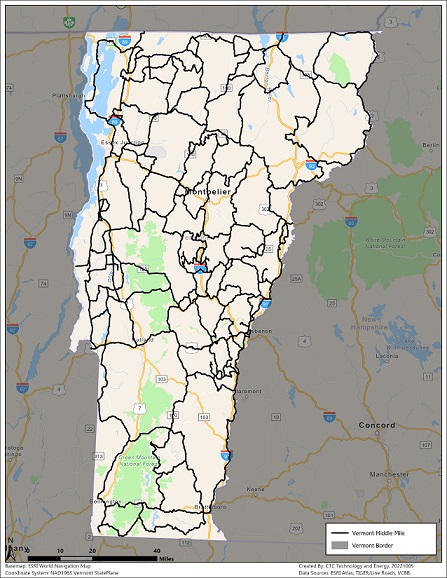Fiber Optic Cable Transferred to CUDs
Thank you for your interest in the Fiber Optic Network formerly managed by the Department of Public Service.
Act 71 (2021) transferred ownership of the former VTA (VT Telecommunications Authority) fiber optic assets, from the Department to the communications union districts (CUDs) in which those assets are located. The transfer included the rights and obligations under any existing contracts or lease agreements with third parties regarding the maintenance or use of the fiber optic assets.
Existing Middle Mile Fiber Optic Cable
About the network
Vermont's Communications Union Districts (CUDs) administer a middle-mile fiber optic network consisting of 340 route-miles of open-access dark fiber. Each segment contains 144 strands of fiber that allow access to multiple tenants. "Middle mile" means that the fiber does not connect to individual buildings; however, it can be used as part of a larger network to bring fiber to individual users, or "fiber-to-the-the-premises" (FTTP). The fiber is considered to be "open access," meaning it is available to any paying applicant for any lawful purpose, whether it is for long haul transmission or as a component of a last-mile FTTP project.
History
This middle-mile fiber optic network was the first public communications infrastructure built in the state, by the Vermont Telecommunications Authority (VTA)—a quasi-state entity created by the legislature in 2007 (30 V.S.A. § 8061) for that purpose. When the VTA ceased operations in 2014, the state transferred the fiber to the Department of Public Service. In 2021, ownership was transferred to the Communications Union Districts (CUDs) as more appropriate entities to use and maintain these networks. Neither the Department nor the Vermont Community Broadband Board (VCBB) are currently involved in providing service or determining leasing arrangements for this fiber.
Maps and GIS data
The web map below depicts the fiber routes:
The GIS (Geographic Information System) data for the routes can be found on the state's Open Geodata Portal:
Contact Information
Please contact the CUDs below for more information:
- NEK Broadband: Christa Shute director@nekbroadband.org (170 miles)
- EC Fiber: Tom Cecere tom.cecere@valley.net (153 miles)
- DVFiber: Steven John Steven.John@dvfiber.net (13 miles)
Middle Mile Network Proposal
In collaboration with the state’s CUDs, and after identifying the needs of many of the state's major telecommunication companies (FirstLight, Consolidated Communications/Fidium Fiber, WCVT, and VTel), the VCBB developed a comprehensive proposal for a statewide middle mile network with significant cross-sector benefits, which would leverage previously built state fiber that was transferred to the CUDs in late 2021.
This project would leverage 347 miles of Indefeasible right of use (IRU) — a telecommunications lease permanent contractual agreement that cannot be undone — as well as 209 miles of existing fiber; 1,107 miles of fiber will be new construction.
Network Map

Key Facts
- This project would leverage 347 miles of IRUs as well as 209 miles of existing fiber; 1,107 miles of fiber would be new construction.
- The middle-mile network would support reliable Internet access to households throughout Vermont, including in the most rural areas of the state.
- This project would be a dark fiber network that would be capable of delivering gigabit symmetrical service to at least 224 critical community anchor institutions within 1,000 feet of the proposed network routes.
- The Vermont Middle Mile Infrastructure Project and the resulting network would be managed by a new Special Purpose Vehicle (SPV), a separate legal entity with majority public control for the purpose of constructing, owning, and operating the network composed of the CUDs and private partners providing Indefeasible Rights of Use (IRUs) to their networks. Vermont has used SPVs effectively with its shared electric utility substations and the same model will be used for this shared telecommunications asset.
Benefits
- Increased Redundancy and Resiliency
The resulting network would increase the redundancy and resiliency of the networks being built by the CUDs, as well as existing privately owned networks. This increases up-time and improves the resiliency of the entire network to natural and other disasters. - Public Safety
The proposal addresses public safety concerns related to e911 call failures caused by some existing hubs that only have one fiber optic feed. The proposal is designed to ensure a minimum of two geographically separate feeds for each hub. The proposed project would eliminate host isolation issues experienced by incumbent telecom providers. - Energy and Climate
The network would further the goal of providing for connections to all renewable energy locations over 150 kW, increasing the resiliency of the electric grid. The improved access to fiber would also increase energy equity by allowing all Vermonters access to various renewable energy and efficiency programs. - Transportation
By providing ubiquitous fiber throughout the state, this effort would enable the Agency of Transportation (AOT) to replace less than reliable and limited bandwidth connections to the 55 road weather information systems; provide secure and reliable network connections to vehicle probe systems for public safety at border checkpoints; provide reliable connectivity and expand road messaging systems; enable electric vehicle charging – chargers at every interchange as well as every 25 miles on the interstate; support Vermont’s micro-transit models, which includes ride-share and real-time pickup; improve data connections for Vermont’s scale and commercial screening stations – 64 total; and provide reliable connectivity to AOT garages and offices across the state – currently, some have poor connections, such as the Newport customer office. - Additional Benefits
The VCBB’s approach of combining newly built infrastructure with additional, low-cost, public rights to both the new and existing infrastructure from for-profit partners would open a world of opportunities for increased collaboration around digital equity efforts and resource sharing at a lower cost between libraries, schools, and healthcare facilities. In the future, when existing contracts expire, the network would also provide a lower-cost public option for the state. Partners also expect to deploy last-mile distribution infrastructure on the poles at the same time as construction to reduce costs and expedite deployment.
